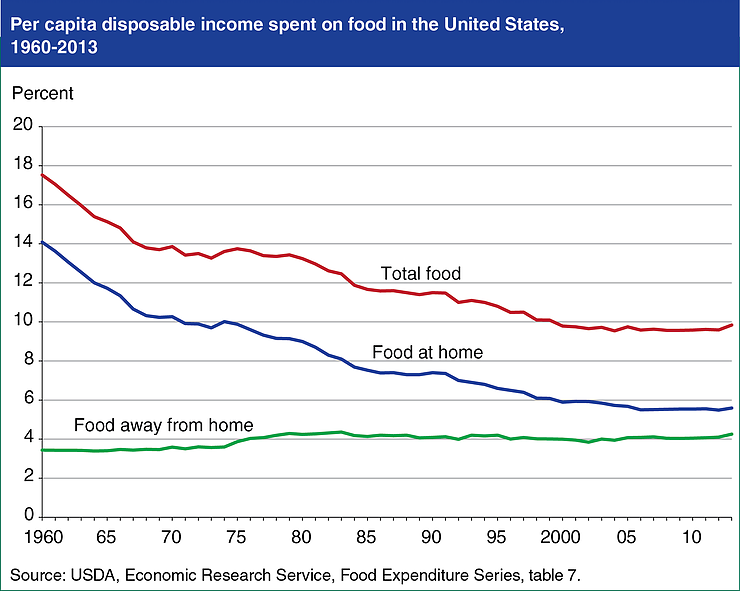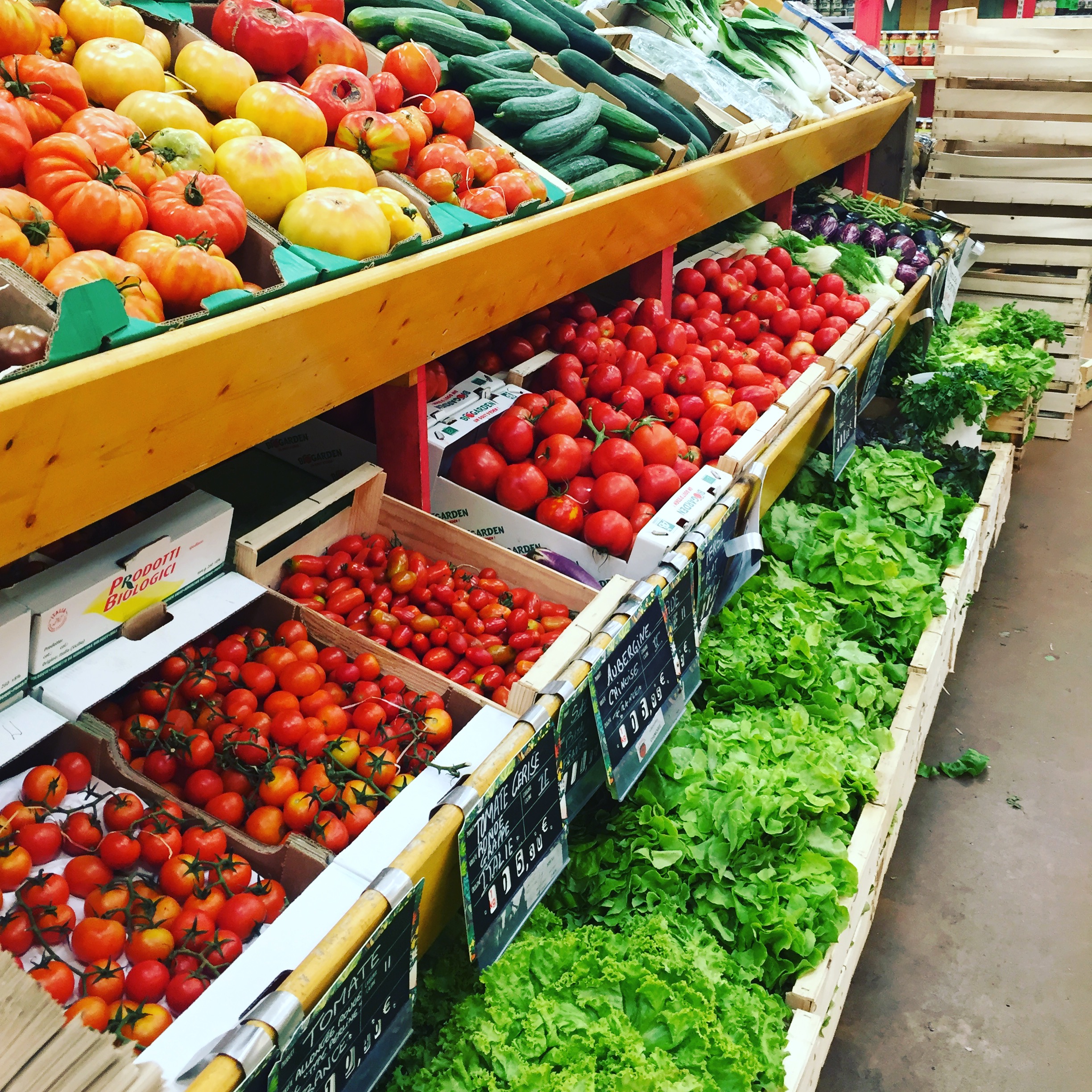
When you start making the change over to healthier foods your wallet usually notices first. Unfortunately organic, pasture-raised, and grass-fed foods do cost more than processed conventional products and this can be a real deterrent for many people.
However healthy does not have to mean expensive. And actually there are many ways you can stretch your food dollars while still choosing the kind of diet that will support your optimal healthiest self.
Before I outline some strategies I want to first take a minute to talk about how much of your budget is actually dedicated towards food. Arguably, the food you put into your body is the single most important predictor of your health. As such, I would hope that your monthly allocation towards food is given this priority.
Your Grandparents Spent More Than You
For many Americans this is not the case. Consider for a moment that according to a review recently published by the United States Department of Agriculture, spending on food, proportional to income, has actually declined dramatically since 1960. Our grandparents spent an average of 17.5% of their total income on food compared to today, where most Americans spend less than 10%.

Now consider how this compares to the rest of the world. In Guatemala and the Phillipines, about 40% of their household expenses went to food and in France and Japan about 14%. That same year, 2013, only 6.7% of household expenses went to food in the U.S.
So maybe the first goal for many of us is to take a second look at our budget and where our money is going each month.
How much are you spending on food (groceries versus eating out) compared to other expenses?
Is it possible to move some money around in order for you to more easily meet the cost of a healthier diet?
It might take a little creative accounting but it’s definitely worth the effort. Just some food for thought.
13 Ways to Spend Less While Eating Better
Regardless of how many food dollars you have available to work with each month there are many tricks and tips you can use to stretch your dollars as far as possible. Let’s take a look at some of them.
Your #1 Strategy: Meal Planning
Your number one money saver is consistent and regular meal planning. When you meal plan, you only buy what you’re going to eat, and you end up with a lot less food waste (which is essentially dollars down the drain or in the garbage as the case may be). In addition to dinners, plan out your lunches and snacks too and you won’t have to rely on grabbing something when you’re out and about.
#2: Shop From Your List
Don’t stray from your list at the grocery store. Again, the goal is to only buy what you need for your meals and snacks for the week. Don’t get sucked into extra treats or snacks that end up adding dollar signs to your grocery bill. When comparing similar products use the price per ounce label to help you determine the brand that has a better cost point. And shop around for markets with better deals. Unfortunately it might not be your go-to store. Check out the ethnic markets in your town. They often have better prices on fresh & specialty ingredients.
#3: Cook at Home
Although when you’re buying organic, high quality ingredients it may not always seem that you’re saving money by eating at home. But in actuality if you were eating that same high-quality food at a restaurant you would be paying much more for that meal. A really good example is lunch. If you’re bringing lunch from home, you can easily pack some leftovers so actually you’re getting two meals from the cost of one. However if you’re eating out for lunch I doubt you’d be able to find a “healthy” meal at less than $5-10. That adds up quickly.
#4: Buy Whole Foods
Choosing foods in their whole form is usually less expensive than buying pre-washed, pre-chopped, prepared foods. Some examples include buying a head of lettuce versus a box of triple washed lettuce. Or in the meat department buying a whole chicken rather than chicken breasts. Of course the convenience and time saving benefit of purchasing prepared foods may actually be worth the cost to you but you will have to determine that for yourself.
#5: Buy Seasonal & Local
Buying produce in season is not only healthier and tastier but it also saves money. If it’s the dead of winter and you’re not finding a lot of seasonal choices at your market, then head to the freezer section. Frozen fruits and veggies are still quite good for you and often cost a lot less than the same item shipped half-way across the world.
#6: Time Your Farmers’ Market Visit
Get to know your local suppliers of food. Besides supporting your local farmers, you can often develop relationships that will save you money. A great strategy is to head to the Farmers’ Market about an hour before it closes. Although you may not get the best pick, the farmers will be anxious to off-load what remains and you’ll get better prices.
#7: Stock Up On Staples
Whether you’re using coupons or just keeping a look-out for what’s on sale at your local market, stock up on staples whenever possible. Dry-goods or foods that can be kept in the freezer are all great to buy when on sale. This is especially true for more expensive items, like meat or fish.
#8: Grow Your Own Food
Whether you have a sprawling backyard, a porch, or just a kitchen window you can grow food. Depending on what space you have available start with things you use on a regular basis; herbs, lettuce, kale, green onions, etc. Get some more ideas of how to start a garden here.
#9: Batch it Baby
Batch cooking is a great time and money saver. Making extra of what you’re already planning on eating then freezing it for a later meal keeps you stocked with healthy back-up meals but also allows you to stretch your food farther without resorting to eating out.
#10: Re-Purpose Leftovers
Don’t let leftover food go to waste, even if you don’t like leftovers. If there isn’t enough to freeze for another time then be creative about using it in a different way; in a soup, on top of a salad, in a burrito, etc. Also, get in the habit of using bones and veggie scraps to make delicious and nutritious broth and stock. Let nothing go to waste.
#11: Eat More Plants
Ultimately plant food costs a lot less than animal food so start adding more vegetarian or vegan meals to your repertoire. Buy whole grains and legumes in the bulk bins to save even more money.
#12: Don’t Spend Money on Drinks
Beverages are some of the most over-priced food items out there. Stick with water, teas, and coffee that you make at home. Rather than buy bottled water every time you’re out and about, invest in a reusable glass or stainless steel bottle and bring water with you. And rather than giving Starbucks half your paycheck each month, make your own coffee at home.
#13: Buy What You Can Afford
Admittedly organic and pasture-raised foods are the most healthy for you but they do cost more. So if it’s not possible for you to buy everything organic than buy the best quality you can afford to buy. It’s more important that you’re getting the fruits and veggies in then avoiding them because you can’t afford the organic price.
Other Ideas: Fitness, Supplements, Products
In addition to the money you spend on food consider other ways you can save money each month. Rather than spending money on a gym membership, invest in a good pair of walking/running shoes and a mat. You can exercise at home or with your kids and put that money towards high quality food instead.
I would also suggest you take inventory on how much money you spend on supplements each month. I can’t tell you how many times I’ve had clients tell me they can’t afford to buy better food but meanwhile they’re spending hundreds of dollars every month on a grocery bag full of supplements. Although supplements can play a role in optimizing your health, a pill will never outweigh the benefit you get from a healthy real food diet. I encourage you to first optimize the quality of your diet and put your money towards that. If there’s a specific supplement you need to take for a deficiency or health condition then include that next.
You can also replace some of your more expensive cleaning or body care products with homemade versions. We use white vinegar for most of our cleaning needs at home and it costs a whopping $0.10/ounce. Wellness Mama has a lot of great ideas and recipes for DIY products.
Take Home Message
You don’t have to break the bank to eat healthy. Retailers and restaurants do however offer many opportunities for you to blow your food budget in one fell swoop. So be intentional with your purchases.
There are many ways to eat healthy, even on a very tight budget. Keep in mind that unhealthy food, although sometimes cheaper, ends up costing you twice. You really can’t put a price on good health.
